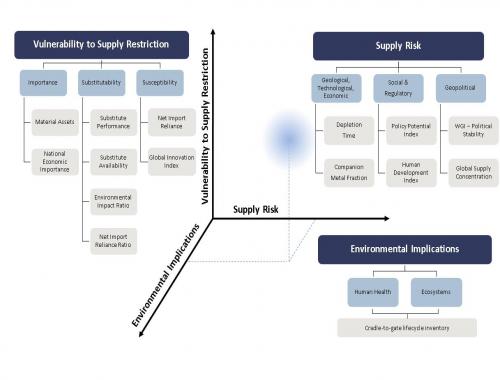The Criticality of Metals
“Criticality” is the quality, state, or degree of being of the highest importance, and is of particular interest in the case of metals and other resources. A comprehensive methodology comprised of three dimensions – supply risk, environmental implications, and vulnerability to supply restriction – has been created to quantify the degree of criticality of the metals of the periodic table. The methodology (shown schematically in Figure 1), a substantial enhancement of a United States National Research Council template, is designed to help corporate, national, and global stakeholders conduct risk evaluation and to inform resource utilization and strategic decision-making. The framework has been constructed to permit flexibility by the user; specific indicators can be deleted or added as desired, and weighted as the user deems appropriate. The value of each indicator will evolve over time, and our future research will focus upon this evolution. The methodology has proven to be sufficiently robust as to make it applicable across the entire spectrum of metals and organizational levels, and provides a structural approach that reflects the multifaceted factors influencing the availability of metals in the 21st century.

Our group is about to complete the assessment of the contemporary criticality for 62 elements (base year 2008), comprising the metals of the periodic table plus metalloids and some other elements. For practical reasons we divide these elements into nine groups (Figure 2).
The first application of this methodology was to the elements of the geological copper family: copper (Cu), arsenic (As), selenium (Se), silver (Ag), tellurium (Te), and gold (Au). These elements are technologically important, but show a substantial variation in different factors relating to their supply risk, vulnerability to supply restriction, and environmental implications. Evaluations of each of the multiple indicators are presented, and the results plotted in “criticality space”. Figure 3 shows the results at the global level. For supply risk, arsenic (As) is the highest of the six metals, with selenium (Se) and silver (Ag) nearly as high. Gold (Au) has the most severe environmental implications ranking. Copper (Cu) and gold have the highest vulnerability to supply restriction rankings at the global level. An extension of this work, now in progress, will provide criticality estimates for several different development scenarios for the period 2010 to 2050.
For further information, please refer to the publications listed below.
Contact: Ermelinda Harper, Project Coordinator (ermelinda.harper@yale.edu)
Publications
Elshkaki, A. and T. E. Graedel. 2013. Dynamic analysis of the global metals flows and stocks in electricity generation technologies. Journal of Cleaner Production 59(0): 260-273.
Erdmann, L. and T. E. Graedel. 2011. Criticality of Non-Fuel Minerals: A Review of Major Approaches and Analyses. Environmental Science & Technology 45(18): 7620-7630.
Graedel, T. E. 2011. On the Future Availability of the Energy Metals. In Annual Review of Materials Research, Vol 41, edited by D. R. Clarke and P. Fratzl. Palo Alto: Annual Reviews.
Graedel, T. E. and L. Erdmann. 2012. Will metal scarcity impede routine industrial use? MRS Bulletin 37(4): 325-331.
Graedel, T. E. and N. T. Nassar. 2013. The criticality of metals: a perspective for geologists. In Ore Deposits in an Evolving Earth, edited by G. R. T. Jenkin, et al.: The Geological Society of London.
Graedel, T. E., E. M. Harper, N. T. Nassar, and B. K. Reck. 2013. On the materials basis of modern society. Proceedings of the National Academy of Sciences of the United States of America doi: 10.1073/pnas.131275211.
Graedel, T. E., R. Barr, C. Chandler, T. Chase, J. Choi, L. Christoffersen, E. Friedlander, C. Henly, C. Jun, N. T. Nassar, D. Schechner, S. Warren, M.-y. Yang, and C. Zhu. 2012. Methodology of Metal Criticality Determination. Environmental Science & Technology 46(2): 1063-1070.
Graedel, T. E. and B. K. Reck. Six Years of Criticality Assessments: What Have We Learned So Far? Journal of Industrial Ecology, accepted.
Greenfield, A. and T. E. Graedel. 2013. The omnivorous diet of modern technology. Resources Conservation and Recycling 74: 1-7.
E. M. Harper, Z. Diao, S. Panousi, P. Nuss, M. J. Eckelman, and T. E. Graedel. Criticality of the nuclear energy metals. Resources Conservation and Recycling, in review.
E. M. Harper, G. Kavlak, L. Burmeister, M. J. Eckelman, S. Erbis, V. S. Espinoza, P. Nuss, and T. E. Graedel. Criticality of the geological zinc, tin, and lead family. Journal of Industrial Ecology, in press.
Nassar, N. T. Platinum-group metal substitutes: A limited set of options. Platinum Metals Review, in review.
Nassar, N. T., R. Barr, M. Browning, Z. Diao, E. Friedlander, E. M. Harper, C. Henly, G. Kavlak, S. Kwatra, C. Jun, S. Warren, M.-Y. Yang, and T. E. Graedel. 2012. Criticality of the Geological Copper Family. Environmental Science & Technology 46(2): 1071-1078.
Nuss, P., E. M. Harper, M. J. Eckelman, N. T. Nassar, B. K. Reck, and T. E. Graedel. 2014. Criticality of iron and its principal alloying elements. Environmental Science & Technology 48(7): 4171-4177.
Panousi, S., E. M. Harper, P. Nuss, M. J. Eckelman, A. Hakimian, and T. E. Graedel. Criticality of Seven Specialty Metals. Journal of Industrial Ecology, accepted.